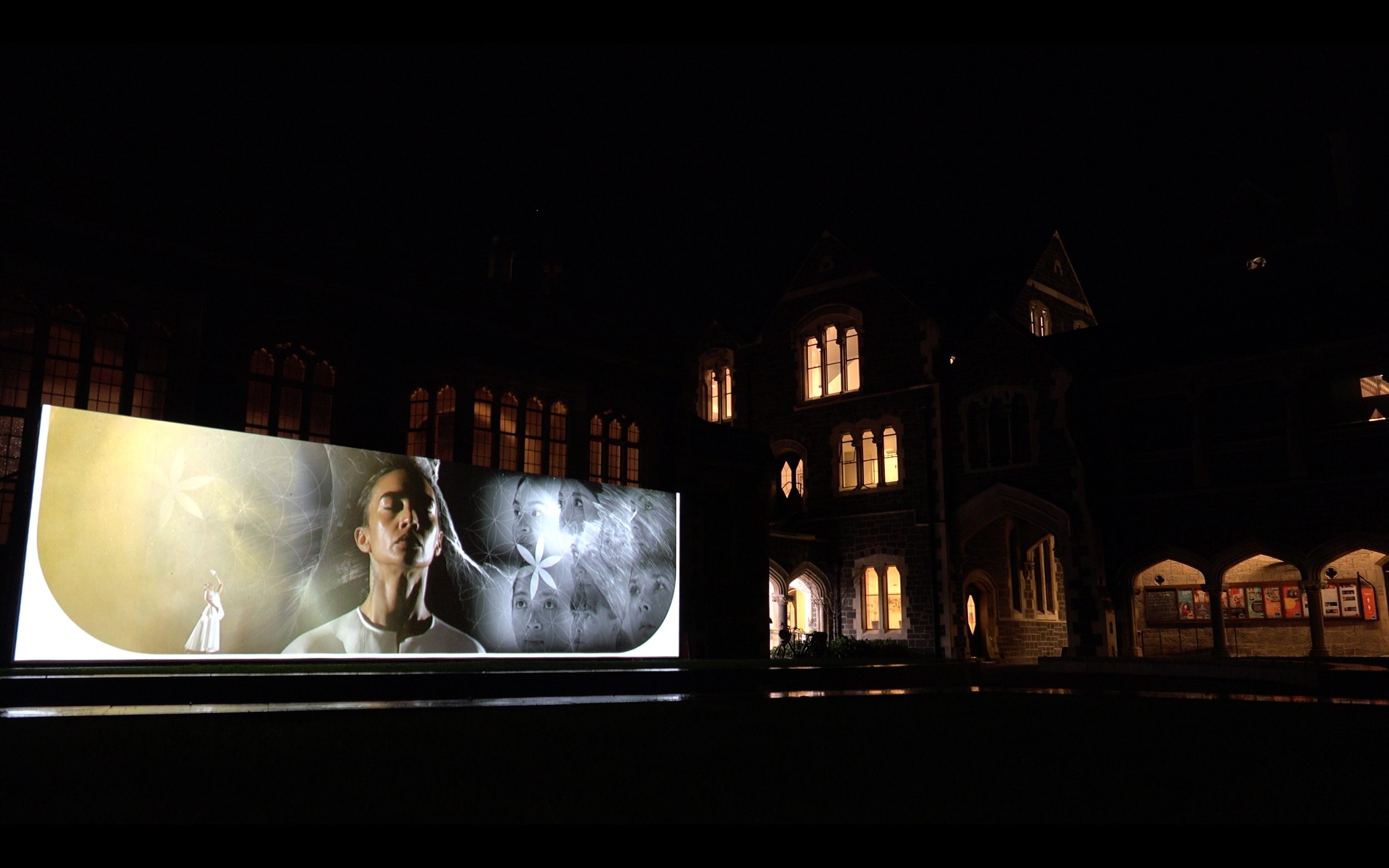Written by Amit Noy
Vibration is the way time moves, landscapes shift, and stars reemerge out of the black to haunt us. Under the spike of each sharp new birth murmur prolonged rhythms—a flutter, a tremble, a sigh.
In 'Ad Parnassum/Purapurawhetū’, a new audiovisual installation by Good Company Arts, it is this ceaseless shifting of everything that underpins each moment. Released during Matariki (the yearly rising of a constellation marking the Māori New Year), the film gives form to a vision of rebirth. Here, regeneration is not a sudden upset, but a slow, piercing wail.
In the beginning there is the figure of a home, etched in delicate white lines. To one side lies a channel of light, filled with striations suggesting a string of mountains, or a passage to the sky. It is there that Jahra Arieta Wasasala stands. They are one of nine movement artists who traverse the work’s thirty-two minutes, each appearing and disappearing amongst a perpetually shifting geometry. In ‘Ad Parnassum/Purapurawhetū’, constellation is relation. The film honours the astral rising as an assemblage—of bodies, figurations, and sounds. With a choreographic ethos, director Daniel Belton crafts a luminous new work, weaving the fabric of many disciplines and traditions into a rhythmical interplay of new life.
Can we see choreography as the way things speak to each other, once brought into closeness? Each dance begins from an active imagination, and ‘Ad Parnassum/Purapurawhetū’ was built by Belton from many points of inspiration. There is Paul Klee’s 1932 painting ‘Ad Parnassum’, which depicts Mount Parnassus, a Grecian site of historical and mythological significance. It was on Mount Parnassus that the nine muses resided: deities of poetry, dance, music, and astronomy. Purapurawhetū, meaning star dust or star steeds, is the Arawa name for tukutuku (or lattice weaving), a Māori art tradition exemplified by artist Sonia Snowden. Purapurawhetū depicts the fabric of the sky, including the nine whētu (stars) of the Matariki constellation. Each whetū in Matariki stewards a vital aspect of holistic life such as fresh water, wind, or a prosperous harvest. In Belton’s rich layering of tradition, the film’s nine performers synthesise this complex lineage of aspiration. They are both the twinkling whetū above Mount Parnassus, and the muses that rest beneath Matariki’s gaze.
Their movement is lively, transformative geometry. As Christina Guieb dances, all the limbic forms of her body become siblings. Her curved spine and gliding head are sisters to the sharp conical form she holds. Each so-called division—arm, head, prop, air, ground—is shown to be enmeshed within the other’s existence. In the digital re-choreography of Guieb’s movement, embodiment is an amalgamation of lines and spheres, and the sharp rod is a dancer, dueting with air and flesh. Belton has created a choreographic singularity by assembling distinct marriages of objects and bodies. These encounters suggest new ways for living with what is foreign, or outside of us. ‘Ad Parnassum/Purapurawhetū’ asks, how else can we dance with all the matter beyond the boundaries of our skin?
Jahra Arieta Wasasala holds two oval forms, and moves them through the air as if sniffing it. The two ovals become curious, like dogs, as Wasasala dances at the edge of the insectile and the mechanical. They are earthly against the floating tapestry of lines that surrounds them.
Dressed in white by Kate Sylvester, the nine performers move in pools of their own echo (a calculated and brilliant digital effect). Each movement leaves a vestigial exhale, and memory is rendered visible as past and present commingle. Like spirits or celestial bodies, they limn the different states of matter: solid, liquid, gas. What of the moment humidity gathers into rain, or water hardens into ice? In ‘Ad Parnassum/Purapurawhetū’, the dancers make the threshold their home.
Occasionally all nine move as a collective, gliding in the distance on curving white prows. Yet most of the time they appear alone—as individuals—in a fecund parade of kinetic identities. Laura Saxon-Jones’ classicism follows Nancy Wijohn’s wiri, just as we listen to the New Zealand String Quartet mingle with Alistair Fraser’s taonga pūoro. Dame Gillian Whitehead’s score stages a delicate and sensuous marriage of sonic ecologies and traditions. As pointillism and tukutuku meet in the film’s inspiration, we listen to the violin converse with taonga pūoro. It is an aural feast. Sound carries the film’s emotional reverberation, and draws us into an elemental rhythm. A low thrum, a keening soar—these vibrations enter our bodies in inexplicable ways, and carry us into a space of feeling. To birth the music, lips embraced landscape: at the work’s opening Fraser plays a hollow ocarina, or three-holed stone, harvested by Belton from the rivers of Te Wai Pounamu. Over thirty-two minutes, Dame Whitehead’s composition encapsulates the grief and joy of regeneration.
Throughout the continual unravelling (of the work and the world), some things change faster than others. It is what remains that anchors you, and in ‘Ad Parnassum/Purapurawhetū’, the anchor is Belton’s and motion graphics artist Jac Grenfell’s gossamer digital worlding. Among bodies and shapes he weaves baroque organisms of line and colour. They cruise through the blackness, evoking an abundance of possibility—seaweed, or continent? Through the care-full work of an astonishing rōpu, guided by director Daniel Belton and creative producer Donnine Harrison, ’Ad Parnassum/Purapurawhetū’ stretches through a broad landscape of actuality.





